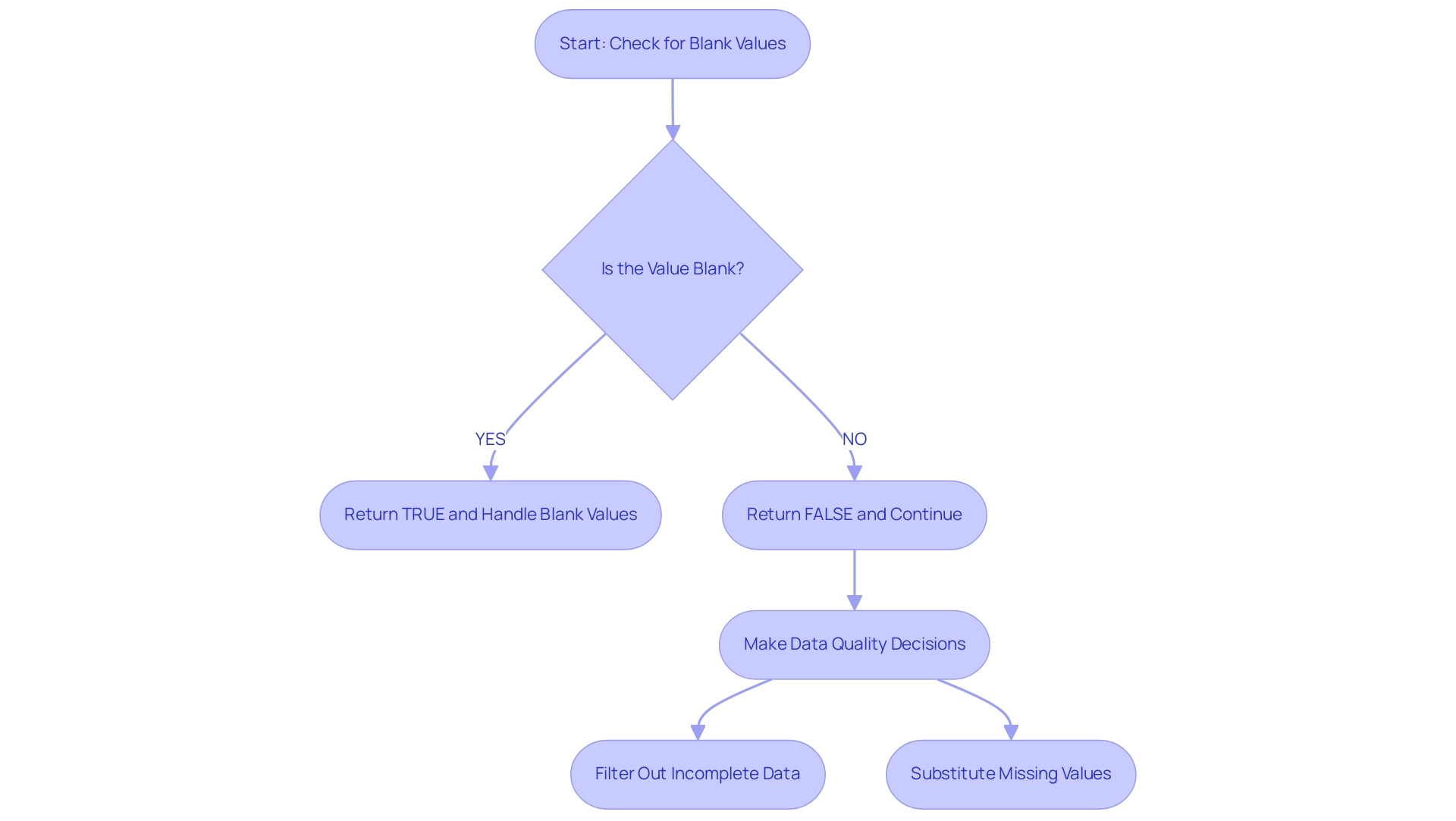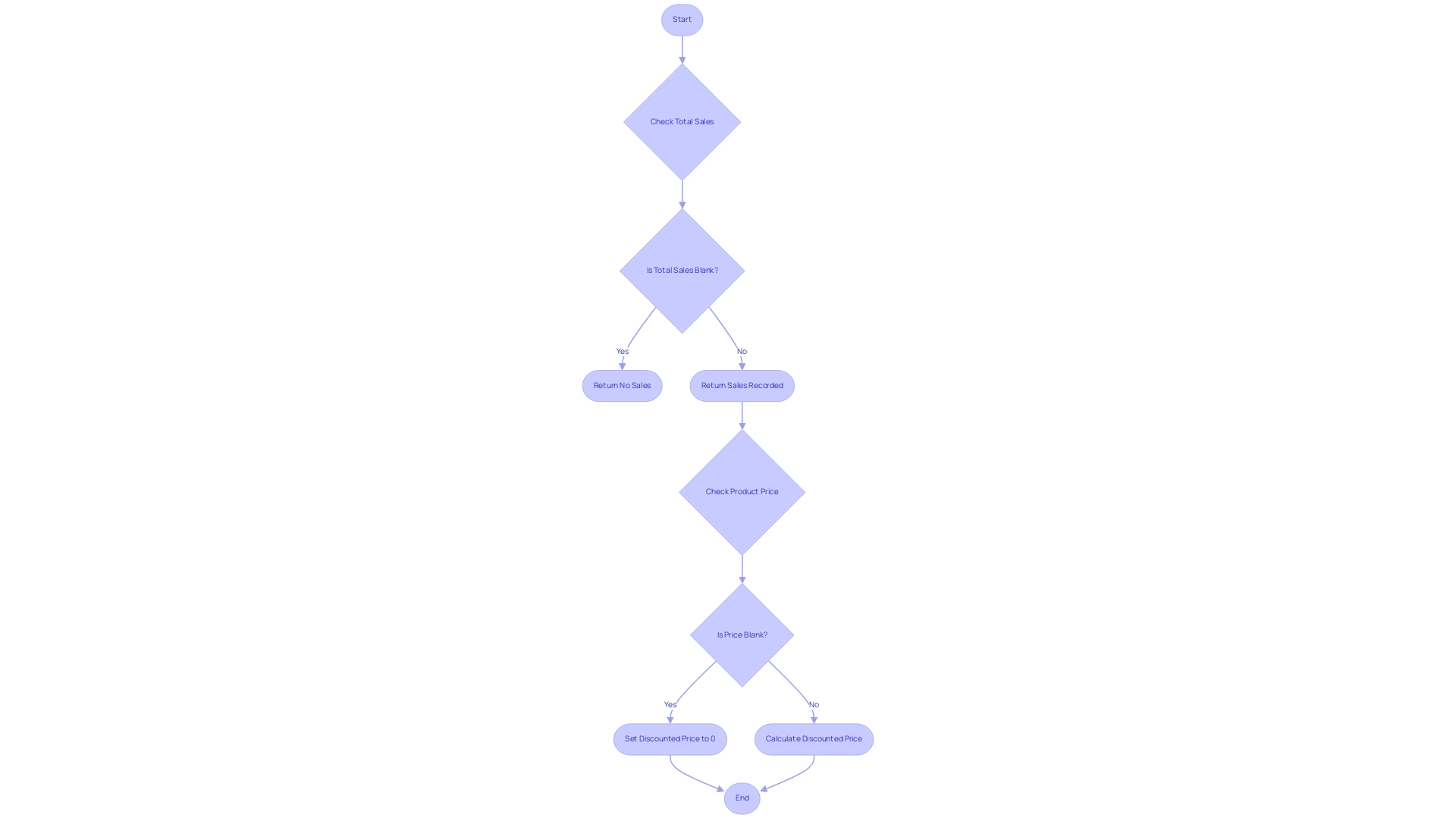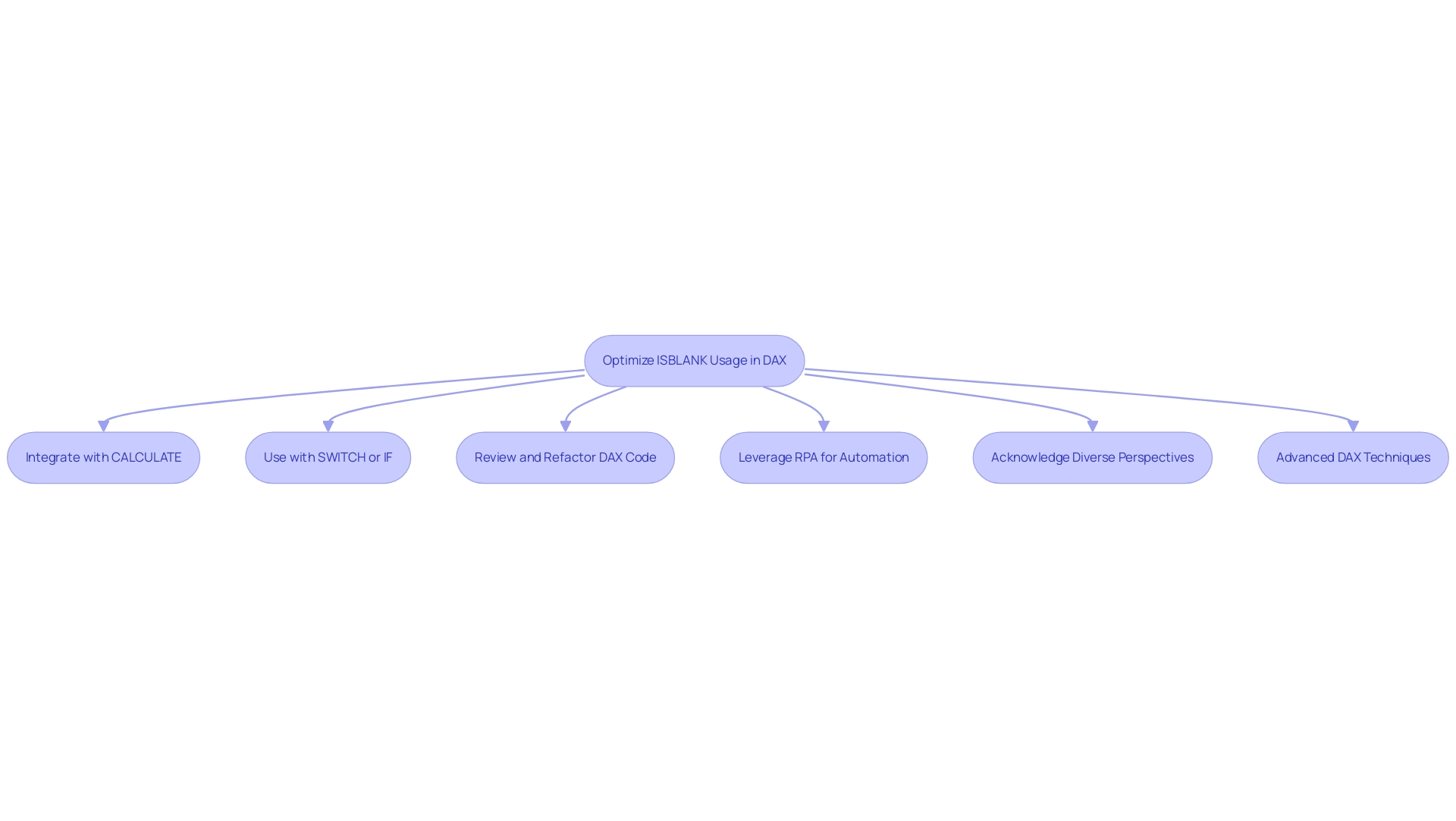Introduction
In the realm of data analysis, the ability to manage and interpret blank values can significantly influence the quality of insights derived from datasets. The ISBLANK function in DAX emerges as an essential tool for data professionals, enabling them to identify and address gaps that could compromise data integrity. By understanding how to effectively utilize ISBLANK, analysts can refine their data models, make informed decisions, and enhance operational efficiency. This article delves into the intricacies of the ISBLANK function, offering practical examples, troubleshooting tips, and advanced techniques that empower organizations to harness the full potential of their data. As businesses increasingly rely on accurate data for strategic decision-making, mastering these concepts becomes crucial for achieving success in today’s competitive landscape.
Understanding the ISBLANK Function in DAX
The DAX function if isblank serves a critical purpose by determining whether a value is blank or empty, returning TRUE for blank values and FALSE otherwise. This foundational tool is essential for analysts aiming to manage and manipulate sets effectively. For instance, in scenarios where a column may contain null values, using a function to check for blanks enables the identification of these gaps, facilitating informed decisions such as filtering out incomplete data or substituting missing values with defaults.
The syntax is straightforward: function(value), with ‘value’ representing the expression to evaluate. Mastering the dax if isblank function for identifying empty values is a crucial step toward creating strong DAX expressions that skillfully manage empty entries. In today’s information-driven landscape, addressing blank values is vital for maintaining integrity and ensuring analytical accuracy, ultimately enhancing the quality of insights derived from your datasets.
Significantly, top-performing firms are 30% more likely to possess a dedicated information catalog, highlighting the importance of effective information management practices associated with empty values. Moreover, organizations face challenges due to poor master information quality and barriers to AI adoption, as highlighted by Welch C., emphasizing the need for improved information quality management:
- ‘Evaluation of two-fold fully conditional specification multiple imputation for longitudinal electronic health record information.’
The possible outcomes of overlooking information quality are illustrated by NASA’s loss of the Mars Climate Orbiter because of format inconsistencies, emphasizing the essential function of the blank-check feature in maintaining information quality and integrity while promoting operational efficiency and business growth.
Additionally, utilizing RPA solutions like EMMA RPA and Power Automate can streamline data management processes, further mitigating the risks associated with poor data quality.

Using IF with ISBLANK: Practical Examples and Scenarios
Employing the IF function alongside the DAX ISBLANK check enables you to efficiently handle empty values within your datasets, improving clarity and insight, which is essential for making data-driven choices in today’s competitive environment. For example, when assessing sales performance, you might want to indicate ‘No Sales’ when the sales value is empty. The following DAX expression accomplishes this:
DAX
Sales Status = IF(ISBLANK(Sales[Total Sales]), "No Sales", "Sales Recorded")
In this instance, the formula checks the ‘Total Sales’ field. If it is discovered to be empty, it returns ‘No Sales’; otherwise, it confirms that sales have indeed been recorded. This method not only refines your data representation but also empowers you to make informed decisions based on complete datasets, addressing the challenges posed by poor master data quality.
Another practical example involves calculating a discount only when the price is available:
DAX
Discounted Price = IF(ISBLANK(Products[Price]), 0, Products[Price] * 0.9)
In this case, if the price is blank, the discounted price is set to 0, ensuring that your calculations remain both accurate and meaningful.
Additionally, consider the case study titled ‘Customer Measures for Blank Names’, where two measures are defined to count customers with empty names and blank names in a dataset, employing the function that checks for blankness. This real-world application demonstrates the effectiveness of DAX ISBLANK in ensuring completeness and highlights the importance of leveraging insights from Power BI dashboards. By incorporating such DAX expressions, specifically DAX ISBLANK, into your analysis, you can significantly enhance information interpretation and operational efficiency.
Moreover, integrating RPA tools like EMMA RPA and Power Automate can further streamline the process of information handling and reporting, helping to automate repetitive tasks and enhance overall operational efficiency. Research has indicated that using DAX functions such as IF can result in a significant enhancement in information representation, aiding improved decision-making and addressing obstacles to AI adoption. Addressing challenges such as time-consuming report creation and data inconsistencies is essential for maximizing the benefits of Business Intelligence solutions.

Troubleshooting Common Issues with ISBLANK in DAX
When using the DAX function dax if isblank, it’s essential to navigate several common issues that can impede your efficiency, especially in the context of Business Intelligence (BI) and Robotic Process Automation (RPA). A prevalent mistake involves overlooking proper syntax; always ensure you are using parentheses correctly to avoid unnecessary errors. Furthermore, many users misunderstand how DAX distinguishes between empty values and zeros—dax if isblank treats these as separate entities.
The function will return TRUE for an empty cell but FALSE for a zero, which can lead to unexpected results, particularly in time-consuming report creation. This misunderstanding is crucial since excessive use of empty cell functions in large datasets can slow down report performance, making careful usage imperative for maintaining operational efficiency. Moreover, it’s essential to understand that Excel considers empty values as zero, while PowerPivot regards them as empty.
If your checks for blank values using dax if isblank are not yielding anticipated outcomes, take a moment to verify the data type of the column in question. For example, if the column is designated as text, confirm that it is genuinely empty and free of spaces, as spaces are not recognized as blanks. Additionally, when utilizing dax if isblank within calculated columns, be mindful of the calculation’s context—this can significantly influence your results, especially when leveraging insights from Power BI dashboards.
A relevant case study highlights the importance of context in DAX calculations, particularly when calculating ratios in PivotTables. Adjustments made in this context ensure that calculations are performed at the cell level rather than the row level, leading to accurate measures that reflect the ratio of Internet Sales to Reseller Sales. By understanding these common pitfalls and the importance of context, you can troubleshoot more effectively and enhance your DAX expressions, ensuring your reports perform optimally.
Moreover, integrating RPA solutions such as EMMA RPA and Power Automate can further streamline your information processing tasks, allowing for more efficient report generation and enhanced operational efficiency. As Bill Pearson, a business intelligence architect, emphasizes, ‘The goal is to get you using DAX and PowerPivot quickly to provide actionable business intelligence in your own environment.’ With these insights, you can transform raw information into actionable insights that drive business growth and innovation.

Advanced Techniques for Optimizing ISBLANK Usage in DAX
To effectively optimize the usage of the function in DAX, leverage it alongside other functions to bolster your data models significantly, thereby enhancing your Business Intelligence capabilities. For example, integrating the absence check within the context of CALCULATE can simplify dataset filtering, removing the necessity to verify for empty values separately. An effective expression could look like this:
DAX
Filtered Sales = CALCULATE(SUM(Sales[Total Sales]), NOT(ISNULL(Sales[Total Sales])))
This expression efficiently sums only those total sales that are not empty, enhancing performance by filtering out unnecessary calculations. Furthermore, integrating DAX if isblank with logical functions such as SWITCH or nested IF statements can accommodate more complex scenarios, ultimately leading to more powerful DAX expressions. Consistently reviewing and refactoring your DAX code to integrate these advanced techniques promotes substantial enhancements in reporting and analytical workflows—essential for addressing obstacles such as time-consuming report creation and inconsistencies.
Additionally, utilizing Robotic Process Automation (RPA) can further streamline workflows by automating repetitive tasks related to preparation and report generation, allowing your team to concentrate on strategic analysis. Customized AI solutions can also contribute to recognizing patterns and insights within your information, enhancing decision-making capabilities. As highlighted in the context of optimizing DAX queries, there are 21 ways to enhance your DAX expressions, which can significantly impact your BI projects.
Acknowledging diverse perspectives and ideas is crucial for successful BI initiatives, as collaboration can lead to more effective solutions. Additionally, advanced DAX techniques, including Time Intelligence functions and iterator functions like SUMX and AVERAGEX, can illustrate the application of DAX if isblank in complex scenarios. This ongoing commitment to optimization not only sharpens your DAX skills but also aligns with the latest trends in DAX performance enhancement, ensuring your data models remain both precise and efficient.
Stay tuned for Part 2 where I will cover more optimizations and discuss the dangers of over-optimization!

Conclusion
Effectively managing blank values within data sets is not merely a technical necessity; it is a strategic imperative for any organization aiming to thrive in today’s data-centric landscape. The ISBLANK function in DAX serves as a powerful tool, allowing analysts to identify and address these gaps, ultimately enhancing data integrity and the quality of insights generated. By mastering ISBLANK, alongside advanced techniques and practical applications, data professionals can significantly refine their analyses and improve operational efficiency.
Utilizing ISBLANK in conjunction with other DAX functions empowers organizations to build robust data models that facilitate informed decision-making. Whether through straightforward implementations like using IF statements or more complex applications within CALCULATE, the versatility of ISBLANK enables analysts to tailor solutions that meet specific business challenges. Furthermore, recognizing common pitfalls and implementing best practices ensures that the use of ISBLANK contributes positively to overall data management efforts.
As data quality remains a cornerstone of successful business intelligence initiatives, investing time in understanding and optimizing the use of the ISBLANK function will yield substantial benefits. By embracing these practices, organizations can not only enhance their analytical capabilities but also foster a culture of data-driven decision-making that propels them toward operational excellence. The journey to effective data management starts with mastering these essential tools, paving the way for greater insights and business growth.

